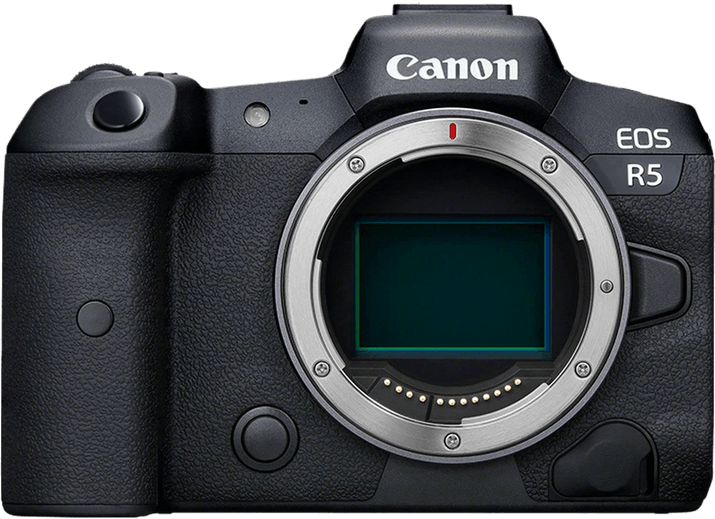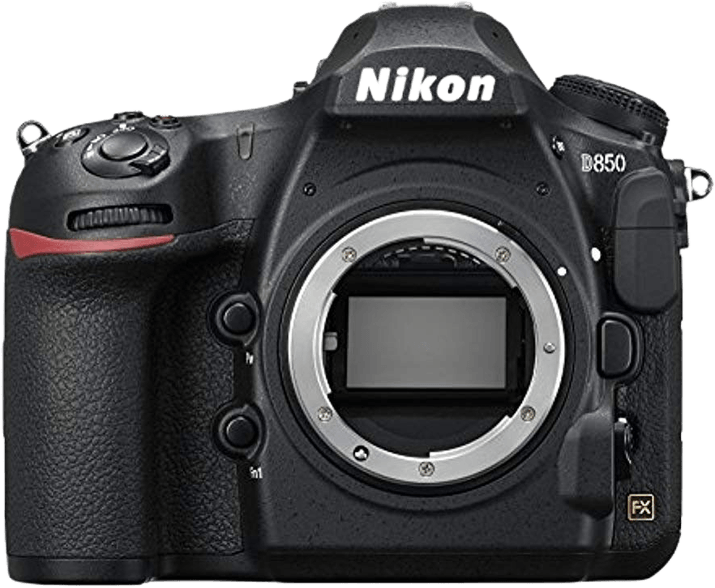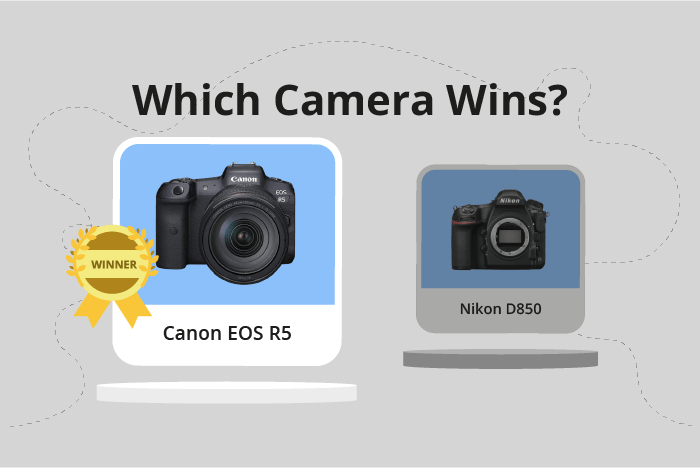Canon EOS R5 vs Nikon D850 Comparison
Canon EOS R5

Nikon D850

The Canon EOS R5 takes the lead with a score of 86/100, while the Nikon D850 trails closely with 82/100. Both cameras, introduced in 2020 and 2017 respectively, are high-quality options for photographers. They share similarities in camera type, with the R5 being a mirrorless camera and the D850 a DSLR.
The Canon EOS R5 outperforms the Nikon D850 with its lighter weight of 680g and compact size of 138 x 98 x 88mm, making it more portable. However, the Nikon D850 has a lower launch price of $3300 compared to the R5’s $4499, making it a more budget-friendly choice.
Considering these factors, the Canon EOS R5 offers superior portability and performance, while the Nikon D850 provides a more cost-effective alternative. Both cameras have their merits, and the choice ultimately depends on the photographer’s preferences and budget.
Canon EOS R5 vs Nikon D850 Overview and Optics
The Canon EOS R5 takes the lead in optics with a score of 88/100, while the Nikon D850 trails behind with a score of 79/100. Both cameras share certain specifications, including a 45-megapixel CMOS sensor, full-frame sensor size, and compatibility with their respective lens mounts (Canon RF and Nikon F FX).
The Canon EOS R5 outperforms the Nikon D850 in several aspects. Its shooting speed of 20 frames per second (fps) is significantly faster than the D850’s 7 fps, allowing for better capturing of fast-moving subjects. Moreover, the R5 features image stabilization, which compensates for camera shake and results in sharper images. This advantage is particularly beneficial in low light situations or when using longer focal lengths. The R5 also utilizes the advanced Digic X processor, which contributes to improved image quality and faster processing speeds.
On the other hand, the Nikon D850 has a slightly higher DXOMARK score for the sensor at 100, compared to the R5’s 95. This difference implies that the D850’s sensor performs better in terms of color depth, dynamic range, and low light performance. However, the absence of image stabilization in the D850 may offset this advantage in certain shooting conditions.
Considering these factors, the Canon EOS R5 emerges as a better choice in terms of optics, primarily due to its faster shooting speed and built-in image stabilization. Although the Nikon D850 has a marginally better sensor performance, the overall advantages offered by the R5 make it a more versatile and capable camera for various photography scenarios.
Canon EOS R5 vs Nikon D850 Video Performance
The Canon EOS R5 outperforms the Nikon D850 in video capabilities, with a video score of 100/100 compared to the D850’s 70/100. Both cameras share some common features, such as built-in time-lapse functionality, which allows for creative and dynamic video content.
The Canon EOS R5 excels in several areas, most notably its maximum video resolution of 8K (8192 x 4320) compared to the Nikon D850’s 4K (3840 x 2160). This substantial difference in resolution allows the R5 to capture exceptionally detailed and vibrant footage. Furthermore, the R5 boasts a max video frame rate of 120fps, while the D850 is limited to 30fps. The higher frame rate on the R5 makes it ideal for capturing smooth slow-motion video and fast-paced action.
On the other hand, the Nikon D850 has some advantages, albeit fewer in comparison. Its 4K video resolution remains adequate for most professional and casual videography needs. Additionally, the D850’s 30fps max video frame rate is sufficient for standard cinematic video production. However, these features do not surpass the capabilities of the Canon EOS R5.
Considering the significant differences in video resolution and frame rate, the Canon EOS R5 is the superior choice for videographers seeking advanced capabilities and exceptional quality. The Nikon D850 remains a suitable option for those with less demanding video requirements or a preference for Nikon’s ecosystem. The choice between the two depends on individual needs and preferences, with the Canon EOS R5 taking the lead in video performance.
Canon EOS R5 vs Nikon D850 Features and Benefits
The Canon EOS R5 and the Nikon D850 both have a feature score of 87/100, making it a tie in this comparison. These cameras share several specifications, including a 3.2-inch screen size, touchscreen capabilities, WIFI, and Bluetooth connectivity. Neither camera has GPS functionality.
The Canon EOS R5 surpasses the Nikon D850 in terms of screen functionality. It features a flip screen, which allows for more versatile shooting angles and better composition in various situations. This advantage makes the EOS R5 more suitable for photographers who require flexibility in their compositions.
On the other hand, the Nikon D850 has a higher screen resolution of 2,359,000 dots, compared to the 2,100,000 dots on the EOS R5. The higher resolution provides a clearer and more detailed display, which is beneficial for photographers who need precise focus and accurate exposure settings.
While both cameras offer impressive features, the Canon EOS R5 stands out for its flip screen, making it more versatile for different shooting scenarios. The Nikon D850, however, offers a higher screen resolution, providing a clearer display for photographers who prioritize precise focus and exposure settings. Ultimately, the choice between these two cameras will depend on the specific needs and preferences of the photographer.
Canon EOS R5 vs Nikon D850 Storage and Battery
The Nikon D850 outperforms the Canon EOS R5 in storage and battery with a score of 84/100 compared to the R5’s 68/100. Both cameras have two memory card slots, accepting SD/SDHC/SDXC (UHS-II compatible) cards. The R5 also accepts CFexpress cards, while the D850 takes XQD cards.
The D850’s superior battery life sets it apart, offering 1840 shots per charge with its EN-EL15a battery. In contrast, the R5’s LP-E6NH battery only provides 320 shots. However, the R5 compensates with USB charging capabilities, a feature the D850 lacks.
Despite the R5’s lower score and shorter battery life, its USB charging offers flexibility for on-the-go photographers. The D850’s longer battery life is ideal for extended shooting sessions without access to charging facilities. Ultimately, the choice between these cameras depends on individual preferences and shooting requirements.
Alternatives to the Canon EOS R5 and Nikon D850
Are you still undecided about which camera is right for you? Have a look at these popular comparisons that feature the Canon EOS R5 or the Nikon D850:

